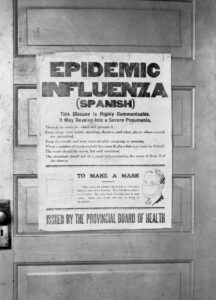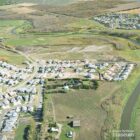Then & Now
St.Albert, Health Epidemic History
May, 2023
St. Albert has endured its share of epidemics and pandemics
St. Albert’s path of progress from a hamlet founded by Father Albert Lacombe to a bustling city of nearly 70,000 citizens hasn’t taken place without a few bumps in the road, some of them rather perilous. The waves of fatal illnesses that swept the world also made their way through the northern Alberta community over the past few centuries, including diphtheria, influenza, scarlet fever, typhoid, and whooping cough. As the city and the world bounces back from the latest international affliction caused by the coronavirus, here’s a brief look at some other major health scares that affected the region over the years.

Smallpox (1870)
In 1520, smallpox first appeared in North America via Spanish explorers trekking through Mexico, but it took more than two centuries for the disease to hit the Canadian prairies. Outbreaks in 1779 and 1838 devastated the aboriginal population, with communities reporting more than half of their people had lost their lives to the infection.
The statistics were more accurate albeit sobering when smallpox hit St. Albert in 1870. The Metis in the area suffered the most with a 37 percent decline in their population. In St. Albert, the affliction struck more than two-thirds of its citizens, of which 311 died within the first four months alone. Those losses could have been considerably higher had a hospital not been built for the Grey Nuns that year. Skilled medical practitioners, the Grey Nuns reportedly treated 692 infected families.
In the historical tome, “The Black Robe’s Vision: A Historyof St. Albert & District,” Lacombe wrote about personally witnessing the ravages of smallpox firsthand. “The pattern is at first very feverish,” he recalled. “The skin becomes red and covered with pimples that form scabs filled with infectious matter, after which the flesh rots and falls off in fragments.”
Spanish Flu (1918-1920)
The 20th century’s deadliest pandemic held much of the globe in its death grip, when up to 500 million people around the world caught the Spanish flu, which killed around 50 million people in nearly three years, according to the Centers for Disease Control and Prevention in the U.S. That morbid figure included 3,000 Albertans of which 300 hailed from St. Albert. Many of them, recorded “The Black Robe’s Vision,” were aboriginal and Metis citizens residing in the lower Grandin area.
“The death toll was high and a frequent sound throughout the district was the mournful tolling of the church bells, notifying the surrounding community of yet another loss,” indicated a passage from “The Black Robe’s Vision.” “Without saying a word, nearby farmers would hitch up their teams and head to the church to find out who had died and how they could help the survivors.”
At the time, no vaccine was available, so more medical practitioners resorted to less pharmaceutical measures from issuing masks and stressing better hygienic practices
to imposing quarantines and curtailing public gatherings
until the affliction ran its course.

Polio (1946-1955)
While northern Alberta had experienced a few outbreaks of polio, the most devastating wave took place shortly after the Second World War, particularly in 1953. That year alone, 266 Albertans came down with polio, of which 12 of them died. It’s not known how many of them were from St. Albert.
“No age or class was spared, but it seemed to be particularly cruel to a generation of young adults,” wrote physician Robert F. Taylor in the book “Polio 1953,” an account of his firsthand experience with the disease in the Edmonton region. “After a short, silent incubation period, victims developed a headache, followed by rapidly progressive paralysis and sometimes death within
three or four days.”
On the medical front lines, Taylor reported that polio struck two doctors and five nurses, of which two of them died while working at the Royal Alexandra Hospital. The rush was on to facilitate patients with iron lung machines, the precursor to the modern ventilator. It wasn’t until Dr. Jonas Salk created a polio vaccine that the disease eventually waned.
COVID-19 (2020-2023)
Remnants of what was first called the coronavirus still exist, albeit in relatively more innocuous variants, serving as reminders of the initial outbreak in Wuhan, China that at last count infected more than 660 million people worldwide and killed some
6.8 million of them. As of August, 2022, nearly 9,000 people in St. Albert had caught the virus, including 88 who died from it.
Within days of the World Health Organization declaring a pandemic on March 11, 2020, the Alberta government declared a provincial state of emergency, resulting in St Albert shutting down public facilities and schools. That July, the city reported its first COVID death. While the government imposed social distancing, quarantines and business shutdowns, the first rollout of a vaccine in December was a much-needed shot in the arm.
In 2021, the Alberta government felt the outbreak had dissipated enough to introduce an ill-fated “Open For Summer” campaign that may have played a part in infections spiking up to 2,000 cases per day by the fall. At one point, in July 2021, St. Albert had only one active case, which jumped to 288 two months later. By the end of the year, St. Albert trailed only Cold Lake as an Alberta municipality having the most per capita cases of coronavirus.
The start of 2022 saw Alberta Health Services report a record 6,735 single-day infections on Jan. 11, including cases involving the omicron variant. The rate plummeted to 466 by late February, prompting the provincial government to lift most restrictions by March 1. By mid-May, AHS reported 10 people were dying daily from COVID, including two St. Albert residents. However, the Alberta government lifted all remaining restrictions on June 14.













